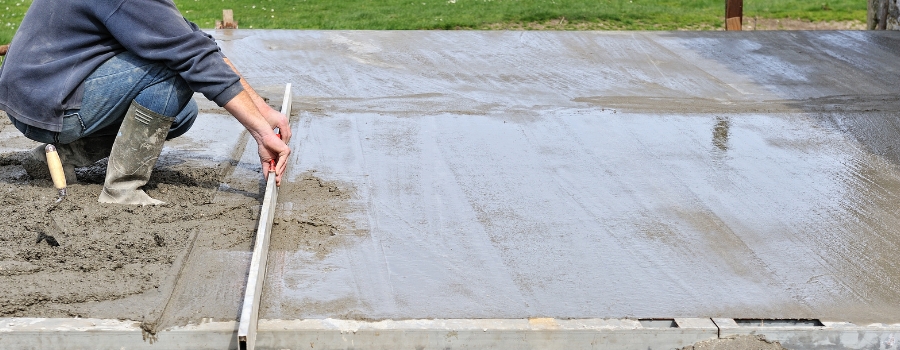Blog Post

Understanding the Concrete Pouring Process: From Start to Finish
Concrete pouring is a crucial part of every construction project. Understanding the process can help ensure a strong and durable result. Despite its simple composition, concrete reigns supreme in construction due to its unmatched strength and durability. It can be moulded into any form, making it highly versatile for complex designs.
Furthermore, its affordability, widespread availability, and fire resistance solidify its place as the go-to material for building everything from foundations to skyscrapers. There are two kinds of concrete: ready mix concrete and site mixed concrete. This guide will walk you through each step of the concrete pouring process.
Planning and Preparation
Before pouring concrete, careful planning is essential. This includes:
Site Inspection
Inspect the site thoroughly. Ensure the ground is stable and can support the concrete structure. Remove any debris, plants, or obstacles that might interfere.
Material Selection
Choose between ready mix concrete and site mixed concrete. Ready mix concrete is pre-mixed and delivered. It's consistent and saves time. Site mixed concrete is mixed on-site. It offers flexibility but requires precise measurement.
Weather Consideration
Plan the pour around weather conditions. Avoid extremely hot, cold, or wet weather. These conditions can affect the curing process and the final strength of the concrete.
Setting Up the Formwork
Formwork is the mould into which concrete is poured. Proper formwork ensures the concrete retains its shape and structure.
Choosing Formwork Materials
Select suitable materials for formwork. Common options include wood, metal, and plastic. The choice depends on the project size and budget.
Assembling the Formwork
Assemble the formwork according to the design. Ensure it is secure and stable. Double-check measurements to avoid errors.
Applying Release Agent
Apply a release agent to the formwork. This prevents the concrete from sticking to the mould. It makes the formwork easier to remove once the concrete has set.
Mixing the Concrete
Mixing concrete properly is crucial. Whether you choose ready mix concrete or site mixed concrete, the process must be precise.
Using Ready Mix Concrete
Ready mix concrete is delivered pre-mixed. This ensures consistency and saves time. The mix is prepared under controlled conditions, guaranteeing quality.
Preparing Site Mixed Concrete
For site mixed concrete, gather materials: cement, sand, aggregate, and water. Measure carefully. Mix the components thoroughly to achieve a uniform consistency.
Pouring the Concrete
Pouring the concrete is a critical step. Proper techniques ensure even distribution and avoid air pockets.
Pouring Techniques
Use appropriate pouring techniques. Pour the concrete evenly across the formwork. Avoid pouring too quickly to prevent segregation of the mix.
Using Concrete Pumps
Concrete pumps are helpful for large or hard-to-reach areas. Line pumps and boom pumps offer different advantages. Choose based on your project needs.
Levelling and Screeding
After pouring, level the concrete using a screed. This ensures a flat surface. Work quickly to prevent the concrete from setting unevenly.
Consolidating the Concrete
Consolidation removes air pockets and ensures a solid mass.
Using Vibrators
Use internal or external vibrators to consolidate the concrete. Vibrate the concrete to remove air bubbles and ensure a dense, solid mass.
Avoiding Over-Vibration
Avoid over-vibrating the concrete. This can cause segregation and weaken the structure. Vibrate just enough to remove air pockets.
Finishing the Surface
Finishing gives the concrete its final appearance and texture.
Initial Finishing
Start finishing as soon as the surface water has evaporated. Use a float to smooth the surface. Work gently to avoid bringing too much water to the top.
Applying Final Finishes
Apply the final finish based on the desired texture. Options include troweling, brushing, or stamping. Each technique offers different aesthetics and slip resistance.
Curing the Concrete
Curing is crucial for developing the concrete's strength.
Importance of Curing
Proper curing maintains moisture and temperature. This helps the concrete develop its full strength.
Curing Methods
Common curing methods include:
Quality Control and Testing
Ensuring the quality of the concrete is essential. Regular testing confirms the strength and durability of the structure.
Conducting Tests
Perform tests such as slump tests, compressive strength tests, and air content tests. These tests help monitor the quality of the concrete.
Addressing Defects
Identify and address defects promptly. Common issues include cracking, segregation, and honeycombing. Fixing these early ensures the longevity of the structure.
Safety Considerations
Safety is paramount during the concrete pouring process.
Personal Protective Equipment (PPE)
Always wear appropriate PPE. This includes gloves, safety glasses, and boots.
Safe Handling of Materials
Handle all materials, especially chemicals, with care. Follow safety guidelines to avoid injuries.
Machinery and Equipment Safety
Ensure all machinery and equipment are in good working condition. Follow operating instructions to prevent accidents.
Conclusion
Understanding the concrete pouring process is vital for any construction project. From planning to curing, each step impacts the final result. Ready mix concrete and site mixed concrete offer different advantages. Choose based on your project's needs.
Save Time Concrete is the best concrete supplier in London. As a professional ready mix supplier in London, we provide numerous services to our clients. Being a concrete supplier in London, our services include screed barrowing, on-site mixed concrete, line pump, boom pump concrete service, retarder admixture, fibres admixture, and accelerator admixture.
With these multiple services, Save Time Concrete has secured the trust of our clients. For all your concrete needs, trust Save Time Concrete.